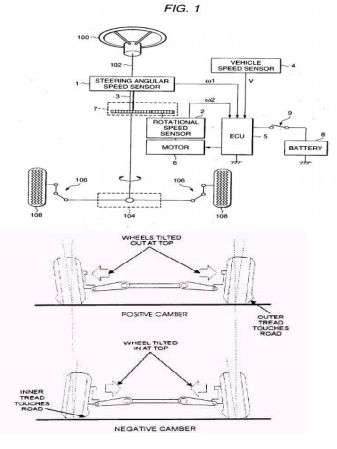Chapter: Mechanical : Automobile Engineering : Steering, Brakesa and Suspension Systems
Power steering
Power steering
In automobiles, power steering (also known as power assisted
steering (PAS) or steering assist system) helps drivers steer by augmenting
steering effort of the steering wheel.
Hydraulic or electric actuators add controlled energy to the
steering mechanism, so the driver needs to provide only modest effort
regardless of conditions. Power steering helps considerably when a vehicle is
stopped or moving slowly. Also, power steering provides some feedback of forces
acting on
the front wheels to give an ongoing sense of how the wheels are interacting
with the road; this is typically called "rοad
feel".
Representative power steering systems for cars augment
steering effort via an actuator, a hydraulic cylinder, which is part of a servo
system. These systems have a direct mechanical connection between the steering
wheel and the linkage that steers the wheels.
This means that power-steering system failure (to augment
effort) still permits the vehicle to be steered using manual effort alone.
Other power steering systems (such as those in the largest
off-road construction vehicles) have no direct mechanical connection to the
steering linkage; they require power. Systems of this kind, with no mechanical
connection, are sometimes called "drive by wire" or "steer by
wire", by analogy with aviation's "fly-by-wire". In this
context, "wire" refers to electrical cables that carry power and
data, not thin-wire-rope mechanical control cables.
In other power steering systems, electric motors provide the
assistance instead of hydraulic systems. As with hydraulic types, power to the
actuator (motor, in this case) is controlled by the rest of the power-steering
system.
Some construction vehicles have a two-part frame with a rugged
hinge in the middle; this hinge allows the front and rear axles to become
non-parallel to steer the vehicle. Opposing hydraulic cylinders move the halves
of the frame relative to each other to steer.
Power steering helps the driver of a vehicle to steer by
directing some of the power to assist in swiveling the steered road wheels
about their steering axes. As vehicles have become heavier and switched to
front wheel drive, particularly using negative offset geometry, along with
increases in tire width and diameter, the effort needed to turn the wheels
about their steering axis has increased, often to the point where major
physical exertion would be needed were it not for power assistance.
To alleviate this auto makers have developed power steering
systems: or more correctly power-assisted steering—on road
going vehicles there has to be a mechanical linkage as a failsafe. There are
two types of power steering systems; hydraulic and electric/electronic. A
hydraulic-electric hybrid system is also possible.A hydraulic power steering
(HPS) uses hydraulic pressure supplied by an engine-driven pump to assist the
motion of turning the steering wheel. Electric power steering (EPS) is more
efficient than the hydraulic power steering, since the electric power steering
motor only needs to provide assistance when the steering wheel is turned,
whereas the hydraulic pump must run constantly.
In EPS, the amount of assistance is easily tunable to the
vehicle type, road speed, and even driver preference. An added benefit is the
elimination of environmental hazard posed by leakage and disposal of hydraulic
power steering fluid. In addition, electrical assistance is not lost when the
engine fails or stalls, whereas hydraulic assistance stops working if the
engine stops, making the steering doubly heavy as the driver must now turn not
only the very heavy steering—without any help—but also
the power-assistance system itself.
Speed Sensitive Steering
An outgrowth of power steering is speed sensitive steering,
where the steering is heavily assisted at low speed and lightly assisted at
high speed. The auto makers perceive that motorists might need to make large
steering inputs while manoeuvering for parking, but not while traveling at high
speed. The first vehicle with this feature was the Citroën SM with itsDiravi
layout[citation needed], although rather than altering the amount of assistance
as in modern power steering systems, it altered the pressure on a centring cam
which made the steering wheel try to "spring" back to the
straight-ahead position. Modern speed-sensitive power steering systems reduce
the mechanical or electrical assistance as the vehicle speed increases, giving
a more direct feel. This feature is gradually becoming more common.

Related Topics